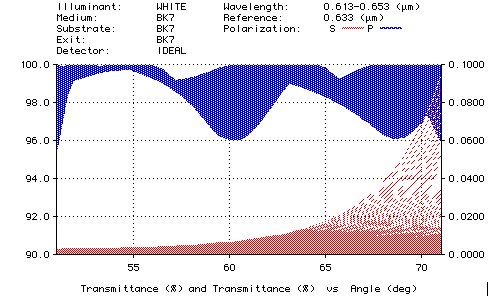Immersed Wide-Angle Polarizer
-
Philip Baumeister, "Rudiments of the design of an immersed polarizing beam divider with
a narrow spectral bandwidth and enhanced angular acceptance,"
Applied Optics, Vol. 36, No. 16, 1 June 1997, pp. 3610-3613.
the author examines the problem of creating narrow-band wide-angle polarizers. He develops a theory for designing this type of coating based on MacNeille pairs of refractive indices. The paper also presents a three-material 17-layer design created using TFCalc. The example given below improves that design by using 17 layers of only two materials.
The goal here is to design a coating to be immersed in a glass (BK7) prism. It should transmit P polarization and reflect S polarization for wavelengths 613-653 nm and angles (in glass) 51-71 degrees. This is diagramed below; the shaded areas represent the cones of incoming and outgoing light.

- P Transmittance > 96% for wavelengths 613-653 nm
- S Transmittance < 0.1% for wavelengths 613-653 nm
The coating materials are SiO2 (index 1.45) and TiO2 (index 2.35). Starting with a single thin layer of TiO2, the designer used TFCalc's optimization capabilities to find a 17-layer design whose performance is shown below.

Here is the design, with the first layer closest to the second glass and
thickness given in nm:
TIO2 83.62
SIO2 74.91
TIO2 94.86
SIO2 119.09
TIO2 90.21
SIO2 129.48
TIO2 81.87
SIO2 123.04
TIO2 84.03
SIO2 138.23
TIO2 81.34
SIO2 131.15
TIO2 83.85
SIO2 152.21
TIO2 80.48
SIO2 126.78
TIO2 59.95
Thanks to Philip Baumeister for supplying this problem.